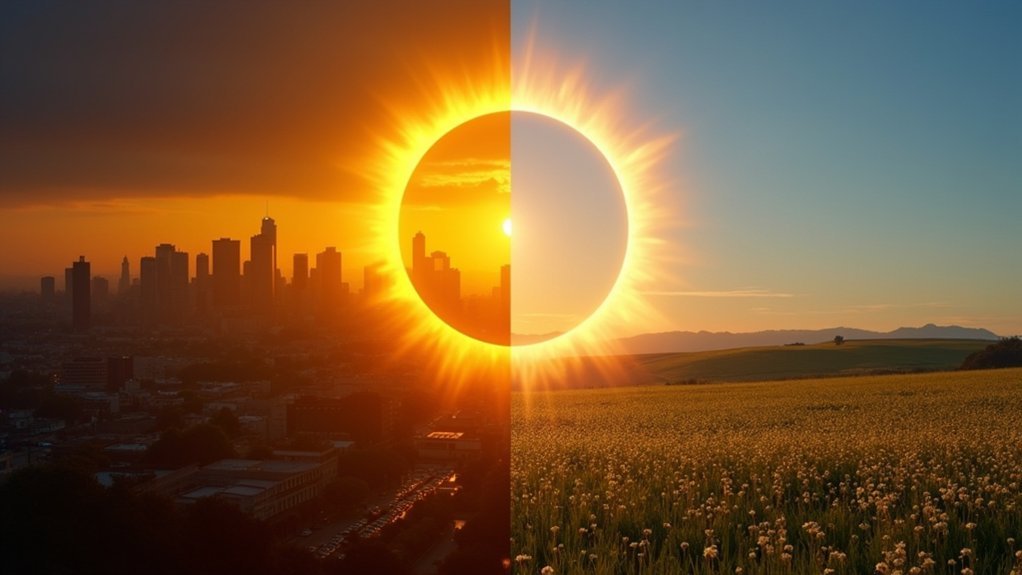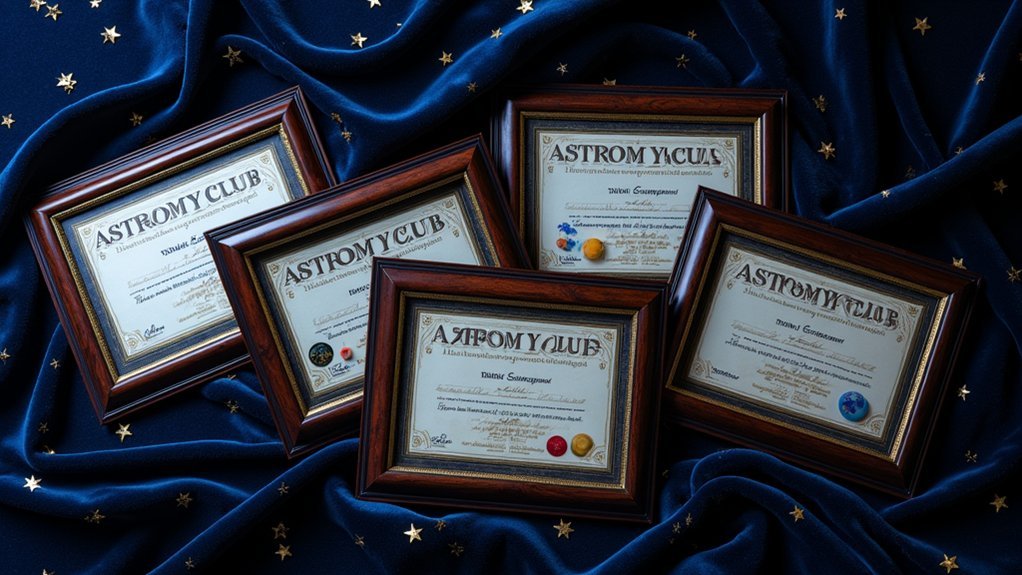To find your perfect solar eclipse viewing location, prioritize spots along the path of totality‘s centerline to maximize your viewing time. Use NASA’s visualization tools or Xavier Jubier’s Google Map to pinpoint specific coordinates. Consider historical weather patterns, with Mexico and Texas offering clearer April skies. Weigh urban conveniences against rural clarity, and factor in accessibility and photography needs. Your ideal eclipse experience depends on precise positioning within that narrow 115-mile corridor of cosmic alignment.
Understanding the Path of Totality: Key to the Perfect Viewing Spot

When planning to witness a solar eclipse, nothing matters more than positioning yourself within the path of totality—a narrow corridor approximately 115 miles wide where the Moon completely covers the Sun.
For the April 8, 2024 eclipse, your exact location within this path considerably impacts your viewing experience.
To maximize the duration of totality, you’ll want to be as close to the centerline as possible, where you can enjoy up to four minutes of darkness.
Remember that the Moon’s shadow races across Earth at nearly 5000 mph, causing the path to narrow as it travels.
Before viewing the eclipse, check local start and end times, as they vary by location.
Interactive maps can help you pinpoint the exact duration for specific spots, ensuring you don’t miss a second of this rare celestial event.
Essential Tools for Tracking Future Eclipse Paths
You’ll find interactive mapping applications like NASA’s visualization tools and Xavier Jubier’s Google Map essential for pinpointing your ideal eclipse viewing location.
These resources allow you to identify exactly where and when totality will occur, with precise details about the eclipse’s path across different geographic areas.
Complementing these maps, eclipse duration calculators help you determine how long the spectacular phenomenon will last at your chosen spot, ensuring you don’t miss a second of this rare celestial event.
Interactive Mapping Applications
Anyone planning to witness a solar eclipse needs reliable tools to pinpoint the best viewing locations. Interactive mapping applications like NASA Map and Google Maps by Xavier Jubier offer detailed visual representations of eclipse paths, helping you find ideal viewing spots.
These tools display the path of totality—typically 115 miles wide—allowing you to plan your experience based on proximity to the centerline for maximum duration.
- Check local time when using these tools, as the Moon’s shadow crosses multiple time zones
- Use the ZIP Code & Location Lookup tool for quick initial searches
- Verify results with location-based tools for greater precision
- Remember that different parts of a ZIP code may experience different eclipse phases
- Position yourself within the path of totality for the full eclipse experience
Eclipse Duration Calculators
Eclipse Duration Calculators help transform your eclipse planning from approximate to precise. These essential tools provide exact information on how long totality will last at your specific location, allowing you to maximize your viewing experience.
| Tool Type | Function |
|---|---|
| Interactive maps | Visualize the path of totality across regions |
| ZIP code searches | Provide general duration estimates for your area |
| GPS-based calculators | Deliver precise timing for your exact coordinates |
| Mobile applications | Offer real-time updates and countdown timers |
While ZIP code tools offer a starting point, they’re not always exact since totality duration can vary within the same postal area. For maximum accuracy, use NASA maps and coordinate-based calculators that provide specific start and end times for each phase of the total eclipse, ensuring you’re prepared for the perfect moment.
Weather Considerations for Clear Eclipse Viewing

When planning your eclipse viewing location, you’ll want to research historical weather patterns for potential sites, particularly focusing on April cloud cover in places like central Mexico and south-central Texas.
You can improve your chances of clear viewing by checking specialized eclipse weather forecasts in the days leading up to the event, which provide more accurate predictions than general weather services.
The flexibility to relocate within the 115-mile-wide path of totality based on last-minute weather updates will greatly increase your odds of experiencing this celestial spectacle under ideal conditions.
Historical Weather Patterns
Because clear skies are essential for ideal eclipse viewing, understanding historical weather patterns can dramatically improve your chances of witnessing this celestial event.
Research shows that central Mexico and south-central Texas typically offer excellent viewing conditions during April eclipses, with consistently clearer skies than other regions.
- Analyze long-term cloud cover data for your potential viewing locations
- Consider seasonal variations that might affect visibility on your specific eclipse date
- Prioritize regions with historically favorable weather during that time of year
- Look beyond your immediate area if local historical weather patterns suggest frequent cloud cover
- Consult reliable climate resources to compare historical weather patterns across multiple potential sites
When planning your eclipse expedition, don’t gamble with the weather—let historical data guide your location choice for the best viewing experience.
Cloud Cover Forecasting
While historical data provides valuable guidance, real-time cloud cover forecasting becomes increasingly essential as eclipse day approaches. Current predictions favor central Mexico and south-central Texas for clearer skies during the April 8, 2024 total solar eclipse, but you’ll need to monitor conditions closely.
Make the most of specialized weather apps and websites that display detailed cloud cover percentages and precipitation probabilities for potential viewing locations. You’ll want to check these forecasts regularly in the final week before the eclipse.
Consider arriving at your chosen destination 1-2 days early, giving yourself flexibility to relocate if unfavorable conditions develop.
Even a short drive to an adjacent area might mean the difference between experiencing totality through clouds or enjoying crystal-clear views of this remarkable celestial event.
Top Global Destinations for Upcoming Solar Eclipses
As celestial enthusiasts plan their next adventure, several prime viewing locations around the world stand out for upcoming solar eclipses.
You’ll find exceptional opportunities to witness these rare astronomical events across multiple continents in the coming years.
- Mexico & Texas (April 2024) – Experience over four minutes of totality in prime spots like Mazatlán or Kerrville on eclipse day.
- Western United States (October 2023) – Catch the “ring of fire” annular eclipse across Oregon and Texas.
- Spain (2026) – Mark your calendar for this European total solar eclipse destination.
- North Africa (2027) – Prepare for one of the decade’s most anticipated total solar eclipses.
- South-Central Texas – Benefit from favorable weather forecasts increasing your chances of clear skies during North America’s 2024 celestial spectacle.
Urban vs. Rural Viewing Locations: Pros and Cons

Choosing between urban and rural settings for your eclipse viewing experience presents distinct advantages and challenges that can greatly impact your overall enjoyment.
Urban locations like Indianapolis offer convenient amenities such as accommodations and restaurants, plus organized community events to enhance your eclipse experience.
However, city environments often suffer from increased traffic congestion and competition for prime viewing spots. You’ll also contend with light pollution that might diminish visibility.
In contrast, rural areas along the Path of Totality provide clearer skies and less obstruction, creating excellent viewing conditions.
Texas countryside locations offer more space, creating a serene atmosphere for a personal connection with this astronomical phenomenon.
Your decision ultimately depends on whether you prefer convenience and community or tranquility and superior viewing conditions.
Accessibility Factors When Choosing Your Eclipse Site
Beyond the urban-rural decision, practical accessibility considerations will greatly impact your eclipse viewing experience.
When selecting your totality viewing location, prioritize practical elements that guarantee comfort and convenience:
- Position yourself along the center line to maximize your time wearing eclipse glasses during the main event
- Consider population density—larger cities offer better accommodations but attract larger crowds
- Evaluate transportation logistics including parking availability and distance from main roads
- Plan arrival strategies accounting for potential traffic congestion, especially in smaller towns
- Research nearby amenities such as restrooms, food options, and shelter in case of unexpected weather changes
Remember to book accommodations well in advance, as rooms within the path of totality often sell out months before the eclipse date.
Photography-Friendly Eclipse Locations
For photographers hoping to capture the celestial spectacle, several prime locations offer ideal conditions for eclipse photography. Mazatlán, Mexico provides an impressive 4 minutes and 18 seconds of totality with stunning coastal backdrops. In Kerrville, Texas, you’ll experience 4 minutes and 25 seconds at 1:34 p.m. CDT—perfect for midday lighting.
| Location | Totality Duration | Photography Advantage |
|---|---|---|
| Mazatlán | 4m 18s | Spectacular coastal views |
| Kerrville | 4m 25s | Ideal midday lighting |
| Russellville | 4m 11s | Ample capture time |
Both Vincennes, Indiana (4m 5s of totality) and Cape Girardeau, Missouri offer excellent photography opportunities. Cape Girardeau’s proximity to the path of totality plus visitor resources makes it particularly convenient for setting up your total eclipse photography equipment in advance.
Planning Around Eclipse Duration at Different Locations
When planning your eclipse viewing experience, the duration of totality becomes a critical factor that can vary dramatically based on your chosen location.
The April 8, 2024, solar eclipse offers varying totality periods, with some spots providing nearly 4.5 minutes of darkness.
For peak totality, consider:
- Nazas, Mexico: Experience the longest duration at 4 minutes and 28 seconds
- Kerrville, Texas: Enjoy 4 minutes and 25 seconds of the cosmic spectacle
- Russellville, Arkansas: Witness 4 minutes and 11 seconds of totality
- Indianapolis, Indiana: View a shorter but still impressive 3 minutes and 49 seconds
Center line positioning: Stay as close as possible to the eclipse path’s center line for ideal viewing time.
Your position within the eclipse path greatly impacts your viewing experience—even small shifts can reduce totality duration considerably.
Frequently Asked Questions
Where Is the Path of the Next Solar Eclipse?
The path of the next solar eclipse, an annular one on October 14, 2023, will stretch from Oregon to Texas. You’ll want to position yourself along this route to experience this celestial event.
Where Is the Best Spot to View the Upcoming Solar Eclipse?
For the upcoming eclipse, you’ll find ideal viewing in Kerrville, Texas with 4 minutes 25 seconds of totality, or Mazatlán, Mexico with 4 minutes 18 seconds. Arrive early to avoid traffic congestion.
Where Is the Best Place to View the 2026 Eclipse?
For the 2026 annular solar eclipse, you’ll get the best views from Punta Arenas in Chile or Bahía Blanca in Argentina. They’re on the centerline path and offer good weather prospects for February viewing.
Where Will the Solar Eclipse Be Visible?
You’ll see the April 8, 2024 solar eclipse along a path crossing Mexico, the United States, and Canada. Prime viewing spots include Mazatlán, Nazas, Kerrville, Lampasas, and Russellville, where you’ll experience several minutes of totality.
In Summary
When you’ve selected your ideal eclipse viewing location, you’re set for a memorable celestial experience. Remember, the perfect spot balances path positioning, weather prospects, and practical accessibility. Don’t forget to book accommodations well in advance—eclipse tourism grows more popular each year. Whether you’re a photographer, first-time viewer, or seasoned eclipse chaser, your careful location planning will maximize those precious moments of totality.





Leave a Reply